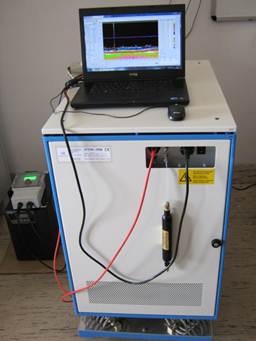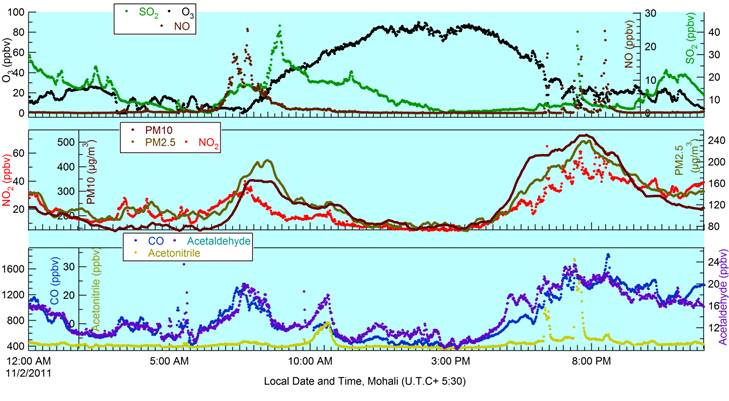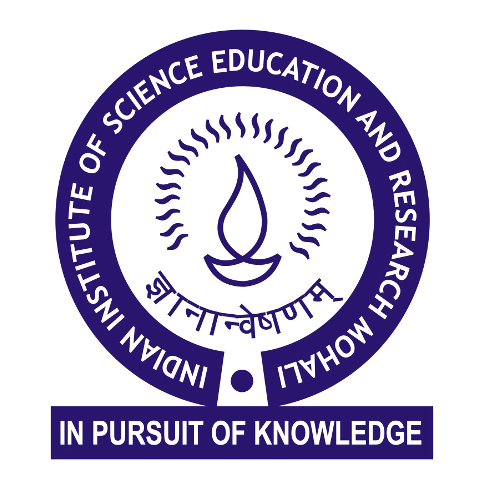BLUE EYE IN THE SKY AT IISER MOHALI

“Blue” eye in the IISER Mohali campus sky: The state of the art atmospheric chemistry and air quality facility
(sampling inlets are on extreme left; the facility is on the extreme right)
IISER Mohali has set up India’s first integrated proton transfer reaction mass spectrometer (PTR-MS) cum ambient air quality facility. This facility will enable frontier research in the area of atmospheric chemistry, climate and air quality by comprehensive long term chemical characterization of ambient air with high time resolution at a site in the northern Indo Gangetic plain.
 |
India’s first Proton Transfer Reaction Mass Spectrometer (PTR-MS):
One of the instruments in the facility capable of measuring volatile organic compounds at parts per trillion level sensitivity in less than a second. |
The meteorology, topography and emission pattern in the densely populated Indo Gangetic plain is very different from the rest of the world and provides a unique “tropospheric reactor” for atmospheric chemistry, air quality and climate interaction investigations. The causal relationship of chemical emissions on climate can be summarily represented as follows:
Emissions into the atmosphere => Impacts composition of atmosphere directly, and indirectly by oxidation to aerosol and carbon dioxide (in multiple steps) => Impacts radiation, activity of cloud condensation nuclei (CCN) and chemistry of the atmosphere => Impacts health and climate
Through this state of the art measurement facility, in addition to regular monitoring of primary air pollutants such as ozone, nitrogen oxides, carbon monoxide, sulphur dioxide, respirable suspended particulate matter (PM 2.5) and suspended particulate matter (PM 10) at high temporal resolution (1 minute), simultaneous high time resolution measurements (few seconds) of a suite of ambient volatile organic compounds that act as the precursors of ozone and secondary organic aerosol will also be available for the first time in India, enabling characterization of in-situ instantaneous ozone production rates and fine mode aerosol (PM 2.5) formation potential to be constrained. Although air quality stations in India have monitored the criteria air pollutants, unavailability of sophisticated instruments such as PTR-MS had prevented quantification of the most reactive precursors of ozone and secondary organic aerosol (e.g. isoprene, acetaldehyde, styrene, trimethyl benzene) that are known to be present in urban ambient air. The facility has started compiling a dataset for ambient levels of harmful organic gases such as acetonitrile for the first time in India. As state of the art research is one of the primary objectives, for criteria air pollutants the recommendations of the Ministry of Environment and Forests, India in respect of specified analytical techniques has been followed and careful quality assurance is ensured through regular calibrations and maintenance checks.
This facility will serve multiple purposes, namely 1) help address uncertainties in atmospheric chemistry, air quality and climate science from such an important region of the world through quality assured long term high time resolution research data and its analysis 2) enthusing students to take up research in a high priority research area of the nation through world class training on sophisticated analytical instrumentation 3) serving the local community by providing information about the daily regional air quality and exceedance levels of criteria air pollutants. Example report is shown below and measured data is shown on the next page).
|
||||||||||||||||||||||||||||||||||
A Snap Shot of One Day (02.11.2011) of Measurements Showing Diel Profiles of Primary Air Pollutants and Select Volatile Organic Compounds Present in the Ambient Air of IISER Mohali

Source : IISER Mohali Atmospheric Chemistry Research Group led by Dr. Vinayak Sinha

